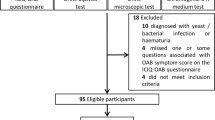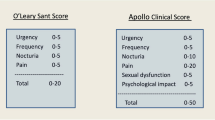Abstract
Purpose of Review
Overactive bladder (OAB) and interstitial cystitis/bladder pain syndrome (IC/BPS) are defined as syndromes consisting of “urinary urgency, usually accompanied by frequency and nocturia, with or without urgency urinary incontinence” and “an unpleasant sensation perceived to be related to the urinary bladder, associated with lower urinary tract symptoms,” respectively. Distinguishing between the two diagnoses can be challenging and although OAB and IC/BPS are traditionally considered separate conditions, more evidence is emerging to suggest a continuum between the symptoms. This review considers the two conditions existing on a continuum by reviewing relevant definitions, phenotypes, and treatment considerations.
Recent Findings
Recent studies have suggested that up to 25% of patients with IC/BPS reported urge incontinence and 35% of patients with OAB described bladder pain. Analysis assessing validated questionnaires revealed that scores could distinguish controls from patients with storage LUTS but were not able to distinguish between those with OAB and IC/BPS. A novel scoring system spanning domain of urgency incontinence and bladder pain was validated and provided 91% diagnostic accuracy.
Summary
OAB and IC/BPS symptoms overlap significantly and it remains unclear if patients with IC/BPS and OAB are unique populations or specific phenotypes of the same condition. We propose that “OAB-dry” patients without fear of leakage may represent a variant of IC/BPS. Unbiased phenotyping based on more accurate symptomatic descriptions may help reveal the correlations of variants of lower urinary tract symptoms with both prognosis and treatment responses.
Similar content being viewed by others
References
Papers of particular interest, published recently, have been highlighted as: • Of importance •• Of major importance
Haylen BT, de Ridder D, Freeman RM, Swift SE, Berghmans B, Lee J, et al. An International Urogynecological Association (IUGA)/International Continence Society (ICS) joint report on the terminology for female pelvic floor dysfunction. Neurourol Urodyn. 2010;29(1):4–20.
• Lightner DJ, Gomelsky A, Souter L, Vasavada SP. Diagnosis and treatment of overactive bladder (non-neurogenic) in adults: AUA/SUFU Guideline Amendment 2019. J Urol. 2019;202(3):558–63. https://doi.org/10.1097/JU.0000000000000309Updated AUA/SUFU guidelines pertaining to the diagnosis and treatment of AUA and OAB. The current guideline included updates pertaining to relevant literature published through October 2018.
Hanno PM, Erickson D, Moldwin R, Faraday MM, The American Urological Association. Diagnosis and treatment of interstitial cystitis/bladder pain syndrome: AUA guideline amendment. J Urol. 2015;193(5):1545–53.
Malde S, Palmisani S, Al-Kaisy A, Sahai A. Guideline of guidelines: bladder pain syndrome. BJU Int. 2018;122(5):729–43.
Anger JT, Le TX, Nissim HA, Rogo-Gupta L, Rashid R, Behniwal A, et al. How dry is “OAB-dry”? Perspectives from patients and physician experts. J Urol. 2012;188(5):1811–5.
•• Ackerman AL, Lai HH, Parameshwar PS, Eilber KS, Anger JT. Symptomatic overlap in overactive bladder and interstitial cystitis/bladder pain syndrome: development of a new algorithm. BJU Int. 2019;123(4):682–93 In this study, a novel scoring system including urgency incontinence and bladder pain was validated with 91% accuracy in differentiating between OAB and IC/BPS.
Kowalik CG, Cohn JA, Delpe S, Kaufman MR, Wein A, Dmochowski RR, et al. Painful bladder symptoms related to somatic syndromes in a convenience sample of community women with overactive bladder symptoms. J Urol. 2018;200(6):1332–7.
Reynolds WS, Mock S, Zhang X, Kaufman M, Wein A, Bruehl S, et al. Somatic syndromes and chronic pain in women with overactive bladder. Neurourol Urodyn. 2017;36(4):1113–8.
Sammarco AG, Kobernik EK, Haefner HK, Till SR, Berger MB. Lower urinary tract symptoms in a chronic pelvic pain population. Female pelvic medicine & reconstructive surgery. 2019.
Apostolidis A, Averbeck MA, Sahai A, Rahnama’i MS, Anding R, Robinson D, et al. Can we create a valid treatment algorithm for patients with drug resistant overactive bladder (OAB) syndrome or detrusor overactivity (DO)? Results from a think tank (ICI-RS 2015). Neurourol Urodyn. 2017;36(4):882–93.
Macdiarmid SA, Sand PK. Diagnosis of interstitial cystitis/ painful bladder syndrome in patients with overactive bladder symptoms. Rev Urol. 2007;9(1):9–16.
Nickel JC, Shoskes D, Irvine-Bird K. Clinical phenotyping of women with interstitial cystitis/painful bladder syndrome: a key to classification and potentially improved management. J Urol. 2009;182(1):155–60.
Hanno PM, Landis JR, Matthews-Cook Y, Kusek J, Nyberg L Jr. The diagnosis of interstitial cystitis revisited: lessons learned from the National Institutes of Health Interstitial Cystitis Database study. J Urol. 1999;161(2):553–7.
Abrams P, Blaivas JG, Stanton SL, Andersen JT. The standardisation of terminology of lower urinary tract function. The International Continence Society Committee on Standardisation of Terminology. Scand J Urol Nephrol Suppl. 1988;114:5–19.
Heeringa R, de Wachter SG, van Kerrebroeck PE, van Koeveringe GA. Normal bladder sensations in healthy volunteers: a focus group investigation. Neurourol Urodyn. 2011;30(7):1350–5.
Heeringa R, van Koeveringe GA, Winkens B, van Kerrebroeck PE, de Wachter SG. Do patients with OAB experience bladder sensations in the same way as healthy volunteers? A focus group investigation. Neurourol Urodyn. 2012;31(4):521–5.
FitzGerald MP, Kenton KS, Brubaker L. Localization of the urge to void in patients with painful bladder syndrome. Neurourol Urodyn. 2005;24(7):633–7.
Smith AL, Nissim HA, Le TX, Khan A, Maliski SL, Litwin MS, et al. Misconceptions and miscommunication among aging women with overactive bladder symptoms. Urology. 2011;77(1):55–9.
Stewart MA. Effective physician-patient communication and health outcomes: a review. Cmaj. 1995;152(9):1423–33.
Greenberg P, Brown J, Yates T, Brown V, Langenberg P, Warren JW. Voiding urges perceived by patients with interstitial cystitis/painful bladder syndrome. Neurourol Urodyn. 2008;27(4):287–90.
Abrams P, Hanno P, Wein A. Overactive bladder and painful bladder syndrome: there need not be confusion. Neurourol Urodyn. 2005;24(2):149–50.
Krieger JN, Stephens AJ, Landis JR, Clemens JQ, Kreder K, Lai HH, et al. Relationship between chronic nonurological associated somatic syndromes and symptom severity in urological chronic pelvic pain syndromes: baseline evaluation of the MAPP study. J Urol. 2015;193(4):1254–62.
Lapides J. Observations on interstitial cystitis. Urology. 1975;5(5):610–1.
Nigro DA, Wein AJ, Foy M, Parsons CL, Williams M, Nyberg LM Jr, et al. Associations among cystoscopic and urodynamic findings for women enrolled in the Interstitial Cystitis Data Base (ICDB) Study. Urology. 1997;49(5A Suppl):86–92.
Waxman JA, Sulak PJ, Kuehl TJ. Cystoscopic findings consistent with interstitial cystitis in normal women undergoing tubal ligation. J Urol. 1998;160(5):1663–7.
Messing E, Pauk D, Schaeffer A, Nieweglowski M, Nyberg LM Jr, Landis JR, et al. Associations among cystoscopic findings and symptoms and physical examination findings in women enrolled in the Interstitial Cystitis Data Base (ICDB) Study. Urology. 1997;49(5A Suppl):81–5.
Fall M, Logadottir Y, Peeker R. Interstitial cystitis is bladder pain syndrome with Hunner’s lesion. Int J Urol. 2014;21(Suppl 1):79–82. https://doi.org/10.1111/iju.12325.
Lee UJ, Scott VC, Rashid R, Behniwal A, Wein AJ, Maliski SL, et al. Defining and managing overactive bladder: disagreement among the experts. Urology. 2013;81(2):257–62.
Nitti VW, Kopp Z, Lin AT, Moore KH, Oefelein M, Mills IW. Can we predict which patient will fail drug treatment for overactive bladder? A think tank discussion. Neurourol Urodyn. 2010;29(4):652–7.
• Kim A, Hoe KO, Shin JH, Choo MS. Evaluation of the incidence and risk factors associated with persistent frequency in interstitial cystitis/bladder pain syndrome and the efficacy of antimuscarinic treatment. Investig Clin Urol. 2017;58(5):353–8 This study reported thatantimuscarinics do not appear to decrease urinary frequency in IC/BPS patients.
Anger JT, Zabihi N, Clemens JQ, Payne CK, Saigal CS, Rodriguez LV. Treatment choice, duration, and cost in patients with interstitial cystitis and painful bladder syndrome. Int Urogynecol J. 2011;22(4):395–400.
Taneja R, Jawade KK. A rational combination of intravesical and systemic agents for the treatment of interstitial cystitis. Scand J Urol Nephrol. 2007;41(6):511–5.
• Di Lena M, Tolls V, Kelly KL, Nickel JC. Mirabegron as adjuvant treatment for patients with interstitial cystitis/bladder pain syndrome. Can Urol Assoc J. 2018;12(3):E100–e4 Mirabegron, a beta-3 adrenergic receptor agonist, may be a useful adjunct to help with urgency, but not necessarily pain, in IC/BPS patients.
Kim TH, Lee KS. Persistence and compliance with medication management in the treatment of overactive bladder. Investig Clin Urol. 2016;57(2):84–93.
• Tutolo M, Ammirati E, Van der Aa F. What is the best treatment option for coexisting pelvic floor dysfunctions? Eur Urol Focus. 2017;3(6):532–4 Sacral neuromodulation (SNM) is used for urinary frequency, urgency, and urgency incontinence in OAB patients. Use in IC/BPS patients is limited (35), but has demonstrated efficacy in helping the frequency/urgency component of IC/BPS.
Gajewski JB, Al-Zahrani AA. The long-term efficacy of sacral neuromodulation in the management of intractable cases of bladder pain syndrome: 14 years of experience in one centre. BJU Int. 2011;107(8):1258–64.
•• Kuo HC, Jiang YH, Tsai YC, Kuo YC. Intravesical botulinum toxin-A injections reduce bladder pain of interstitial cystitis/bladder pain syndrome refractory to conventional treatment—a prospective, multicenter, randomized, double-blind, placebo-controlled clinical trial. Neurourol Urodyn. 2016;35(5):609–14 This prospective, multicenter, randomized, double-blinded, placebo-controlled clinical trial studied the use of Onabotulinumtoxin-A in IC/BPS patients. Onabotulinumtoxin-A was associated with significantly decreased visual analog scores (VAS) for pain and increased bladder capacity in comparison to controls.
Author information
Authors and Affiliations
Corresponding author
Ethics declarations
Conflict of Interest
Dr. Jennifer T. Anger is an expert witness for Boston Scientific. Dr. Kai B. Dallas, Dr. Lenore A. Ackerman, and Dr. Carrie S. Stewart declare that they have no conflict of interest.
Human and Animal Rights and Informed Consent
All procedures performed in studies involving human participants performed by the authors were in accordance with the ethical standards of the institutional and/or national research committee and with the 1964 Helsinki Declaration and its later amendments or comparable ethical standards.
Additional information
Publisher’s Note
Springer Nature remains neutral with regard to jurisdictional claims in published maps and institutional affiliations.
This article is part of the Topical Collection on Reconstructed Bladder Function & Dysfunction
Rights and permissions
About this article
Cite this article
Dallas, K.B., Stewart, C.S., Ackerman, L.A. et al. OAB and IC/BPS: Two Conditions or a Continuum of One?. Curr Bladder Dysfunct Rep 15, 15–20 (2020). https://doi.org/10.1007/s11884-019-00567-y
Published:
Issue Date:
DOI: https://doi.org/10.1007/s11884-019-00567-y




